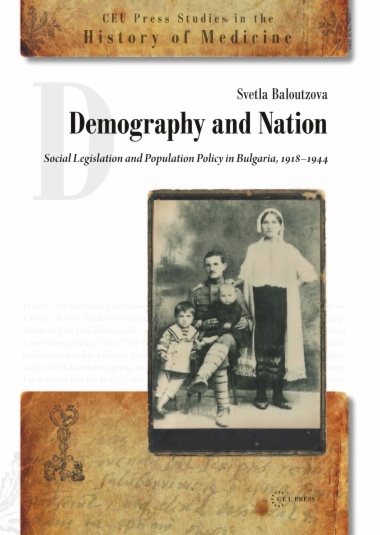The monograph investigates the origins of state policy toward population and the family in Bulgaria. Reconstructs the evolution of state legislation in the field of social policy toward the family between the two World Wars, colored by concerns about the national good and demographic considerations. It sets the laws regarding family welfare in their framework of a distinctively cultural, historical and political discourse to follow the motives behind the legislative initiatives.
- Cover
- Series title page
- Title page
- Copyright page
- Table of contents
- Transliteration table of Bulgarian Cyrillic
- List of Tables
- Acknowledgements
- INTRODUCTION
- 1. Outlining the problem
- The objectives of the research
- Population and population anxieties from a historical perspective
- 2. Methodology
- Approaches: The “regenerated” narrative
- Agents of research and limitations of the research methodology
- Instruments of research
- General limitations of the study
- Sources
- Parliamentary minutes and parliamentary appendices
- Archival units
- Mass media: Newspapers and magazines
- Independent publications
- 3. A historical outline of the period under investigation
- The path to Neuilly (1919)
- Ideological definitions of the era
- 4. Social and demographic structure of interwar Bulgaria
- 5. A history of Bulgarian legislation—an outline
- PART I REGENERATING A DEFEATED NATION
- Chapter 1 Building up a Maternal and Child Healthcare Service
- 1. An “orange” start: The BANU’s Bill for People’s Health (1923)
- An “orange” ideology of healthcare
- Non-codified provisions for maternal and child healthcare
- 2. The Democratic Alliance and the 1929 Law for People’s Health
- Legislative introduction of preventive medicine in Bulgaria
- The 1929 Law for People’s Health and its historical legacy
- “the way they saw it”: The problem of “wishful” social hygiene
- Contradictions between theory and practice
- Fertility decrease and the rediscovery of state welfare
- The failure of the propaganda approach
- The legal reversal
- Chapter 2 Public Assistance
- 1. State protection of the family: The privileged child
- The 1934 Decree-Law for Public Assistance and its legislative aftermath
- 2. Legislation on family allowances in Bulgaria
- Introducing family allowances in Bulgaria—a historical outline
- The political context of the discourse
- The Decree for Family Allowances (1942)
- Binding social welfare and public security
- 3. The disadvantaged child: The Law for Children Born Outside Marriage and Their Avowal, and for Adoption, November 1940
- Early legal debates and modernization
- In the name of the child and its mother, and … security considerations
- Mothers’ rights and international women’s issues
- Reform bills (1924–1933)
- Illegitimacy and media response
- The legal breakthrough (November 1940)
- PART II TOWARDS PRONATALISM
- Chapter 3 Demography, Media representations, and Parliamentary Discourse
- 1. The “discovery” of birth decline
- 2. Demographers on the “collapsing” demographic trend
- 3. Mass media responses to fertility decline
- Ethnic imbalance and military alarm
- Population growth or poverty concerns?
- The image of the “new” family
- 4. Early parliamentary alarm about birth decline
- Chapter 4 Activities “From Below”: The League of Mnogodetni, Child-Rich Parents
- 1. Historical overview
- 2. Organization
- Networks and network activities
- Congresses and symbolism
- Management and membership
- Role models
- 3. Combating poverty
- Child allowances, tax-revisions, and railway fare discounts
- Appeals for land redistribution and justice
- Chapter 5 Petŭr Gabrovski and the Law for Large, Mnogodetni Bulgarian Families
- 1. Ideological background
- 2. The Law for Large, Mnogodetni Bulgarian Families
- Legislative preparations
- Influences and motivation
- Drafts and comments
- Official administrative considerations
- The final version
- 3. The bachelors’ tax controversy
- 4. The legal aftermath
- CONCLUSIONS
- 1. Legislation on the family and children (1918–1944)
- 2. An overview of motives—”The way they saw it”
- 3. Privileged and underprivileged target groups of social legislation
- 4. Political participants and pressure activists
- 5. Aftermath
- Bibliography
- Index
- back cover

